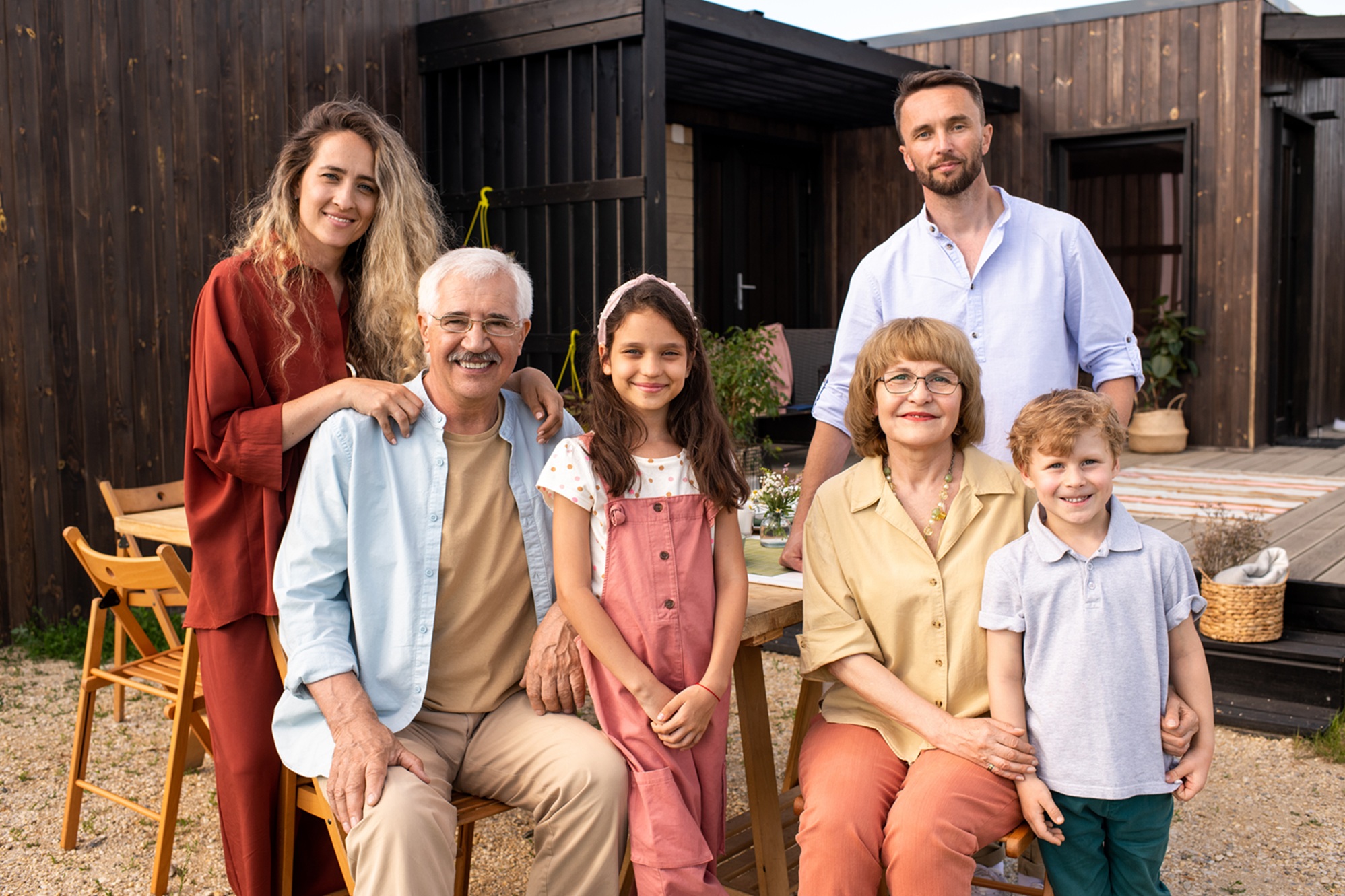Housing costs are rising rapidly, pricing many young families out the market or trapping them in homes they’ve outgrown. Meanwhile, aging parents, determined to age in place independently, are finding it tough to sell the family home and buy a house that fits their needs, in a location they like, and at a price they can afford.
For a growing number of families, these twin pressures have one obvious solution: multi-generational living. A small but increasing percentage of homes in the U.S. are being designed, built, and marketed for multigenerational families who want to share some living space but also have separate parts of the home to come and go as they please in privacy. One builder calls these homes “two houses in one.”
Recently we read this Wall Street Journal article in which reporter Robyn Friedman examined the present state of multigenerational living in America. Her conclusion: the advantages may be obvious, but there are potential pitfalls and friction points, too. No pun intended, but the bottom line before you and the kids (or you and the folks) buy that house together is, “Do your homework.” (Please note that a subscription may be required to access the Wall Street Journal article.)
Number of People in Multigenerational Households is On the Rise
The number of multigenerational households in the U.S. has skyrocketed, Friedman says.
“According to the Pew Research Center, between 1971 and 2021, the last year for which these statistics are available, the number of people living in multigenerational households quadrupled,” she writes. “The trend is driven by financial issues, the need for caregiving for both children and older adults, and delays in new household formation by young adults.”
Those in Communal Living Report Significant Stress
While there are plenty of benefits to communal living, there are challenges, too. In fact, according to Pew, twenty-three percent of adults in multigenerational households say it is stressful all or most of the time, and 40 percent admit it is stressful some of the time.
“That is why flexible floor plans that enhance privacy, a healthy respect for boundaries and candid discussions upfront among family members are key to the success of any multigenerational arrangement,” Friedman writes.
One Family’s Tale: a Home Designed for Multigenerational Living
As an example, Friedman introduces us to the Gibsons: Darlene, 56, and her husband Jim, 58. They have been sharing their 2,600-square-foot Arizona home with Jim’s mom, Cheryl, since they purchased it for $442,490 in 2021. Before this arrangement, 79-year-old Cheryl was living on her own in rural Virginia. She was isolated and dependent on others to get around. Now, the Gibsons are exemplifying an increasingly-prevalent type of living in a style of home that is becoming more popular.
Friedman writes, “Miami-based Lennar has sold its Next Gen home design since 2011, according to Alan Jones, the company’s division president in Tempe, Arizona. These models include an attached private suite with a separate entrance, kitchen, living room, bedroom, bathroom and laundry facilities.”
Jones says, “We call it two homes in one. A person can live in this space completely independent from the other family.”
“Next Gen” Home Design Doesn’t Require a Major Cost Premium
According to Jones, these Next Gen homes make up 25 percent of the company’s sales in the Phoenix market. While prices vary, the price of a typical 3,000-square-foot Next Gen home is around $15,000 more than a home of a similar size without any multigenerational features.
“But Lennar isn’t the only builder offering floor plans designed for multigenerational living,” Friedman notes. “Many homes sold by Fort Washington, Pennsylvania-based Toll Brothers can be customized for multigenerational living as well.”
Certain existing homes are perfectly suitable for multiple generations, too. According to numbers from Realtor.com, about 3.8 percent of homes listed nationally between January 1 and June 21 of this year highlighted an additional dwelling unit—or in-law suite—as part of the listing description. Homes with this feature had a median listing price of 20.6 percent higher than the market median.
For the Gibsons, Mutual Respect is the Essential Key
“Cheryl Gibson now has the equivalent of her own apartment, where she bakes and gets together with friends,” Friedman writes. “She’s lost weight because she’s active in the community, using the clubhouse for bingo and craft night. When she needs to go to a doctor’s appointment, Darlene and Jim are there to support her.”
The key to making this arrangement work? Mutual respect, says Darlene.
“Except for emergencies, no one enters the other party’s living quarters without knocking first and being invited inside,” Friedman writes. “The arrangement also gives the couple peace of mind, knowing they are just a few steps away in case Cheryl has a health issue or needs assistance.”
If multigenerational living is something you’re planning, Friedman presents the following things to consider.
Clarify All Financial Details – Including an Exit Strategy – Before You Move
First, a handshake agreement only goes so far. Hillery Dorner, a real-estate attorney with Massachusetts-based Dorner Law & Title Services, suggests that a written cohabitation agreement including everyone’s expectations, responsibilities, and financial obligations is a necessary starting-point.
“The agreement should include an exit strategy to lay out what happens if one of the parties dies, gets divorced, needs to move to assisted living or just wants to leave the shared home,” Friedman explains.
Zachary D. Schorr, a real-estate attorney in Los Angeles, adds that this exit strategy should also include a method of valuing the home in case one party wants to buy the other out if the property title is held by all parties jointly.
Moreover, this shouldn’t be a static document, says Friedman: plan to revisit the agreement every year or so to update it to reflect changing finances and needs.
Plan Ahead for Legal Contingencies, and Consider Establishing a Trust
“If you need your parents’ help to qualify for a mortgage, it is likely the lender will require them to be on the deed and mortgage,” Friedman writes. “Decide whether you want to own the property as joint tenants with right of survivorship, where the surviving party automatically owns the entirety of the property if the other owner dies, or tenants in common, where a deceased owner’s share goes to his or her heirs, which could possibly leave the survivor as a co-owner with strangers.”
Schorr says that holding a title in the name of a trust is also a good option if the lender allows for it. “With a trust, there would be a mechanism for who gets what if someone dies or wants out,” he says.
Create an Emergency Fund for Unanticipated Repairs and Upgrades
Finally, there’s wisdom in everyone pitching in. Donna Butts, senior fellow at Generations United—a nonprofit that advocates for intergenerational programs and multigenerational living—suggests the creation of an emergency fund to which everyone contributes. This should be saved to cover unexpected repairs or other house-related costs, such as modifying the home to allow older adults to age in place or childproofing the home for young children.
“Updating a home for one generation can positively impact multiple generations,” Butts says, in a wise suggestion that concludes the article. “That front-loading washer makes it easier not just for older adults but for children who want to help. Accessibility enhances everyone’s ability to enjoy the home they share.”
Rajiv Nagaich – Your Retirement Planning Coach and Guide
The long-awaited book by Rajiv Nagaich, called Your Retirement: Dream or Disaster, has been released and is now available to the public. Retirement: Dream or Disaster joins Rajiv’s ground-breaking DVD series and workbook, Master Your Future, as a powerful planning tool in your retirement toolbox. As a friend of AgingOptions, we know you’ll want to get your copy and spread the word.
You’ve heard Rajiv say it repeatedly: 70 percent of retirement plans will fail. If you know someone whose retirement turned into a nightmare when they were forced into a nursing home, went broke paying for care, or became a burden to their families – and you want to make sure it doesn’t happen to you – then this book is must-read.
Through stories, examples, and personal insights, Rajiv takes us along on his journey of expanding awareness about a problem that few are willing to talk about, yet it’s one that results in millions of Americans sleepwalking their way into their worst nightmares about aging. Rajiv lays bare the shortcomings of traditional retirement planning advice, exposes the biases many professionals have about what is best for older adults, and much more.
Rajiv then offers a solution: LifePlanning, his groundbreaking approach to retirement planning. Rajiv explains the essential planning steps and, most importantly, how to develop the framework for these elements to work in concert toward your most deeply held retirement goals.
Your retirement can be the exciting and fulfilling life you’ve always wanted it to be. Start by reading and sharing Rajiv’s important message. And remember, Age On, everyone!
(originally reported at www.wsj.com)


